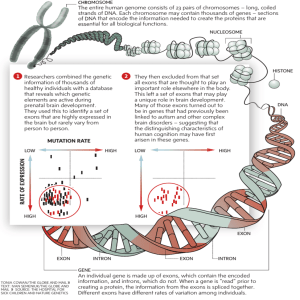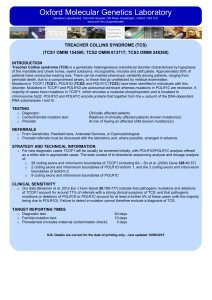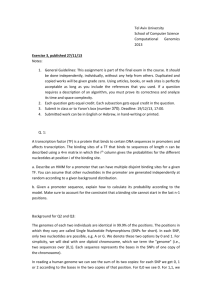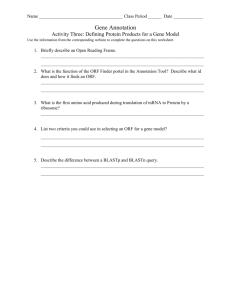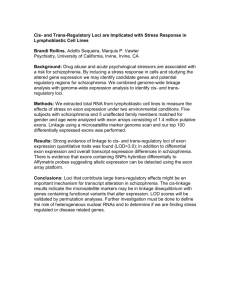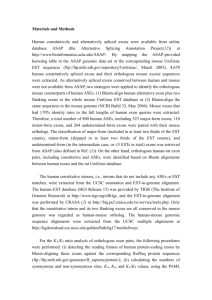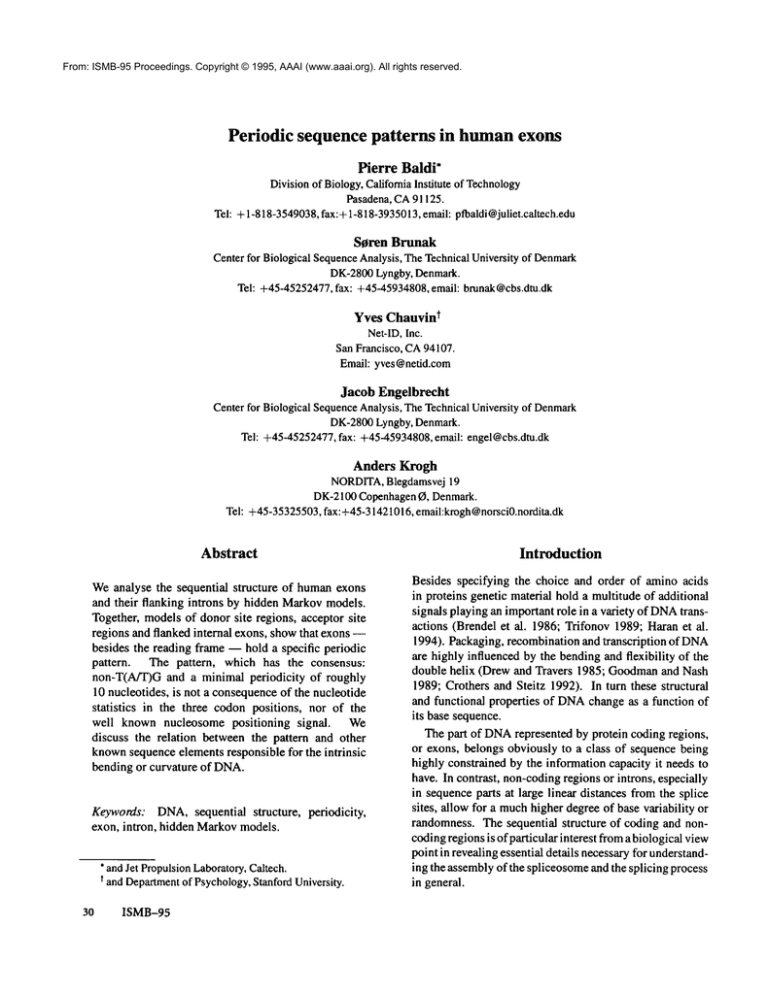
From: ISMB-95 Proceedings. Copyright © 1995, AAAI (www.aaai.org). All rights reserved.
Periodic sequence patterns in humanexons
Pierre Baldi*
Divisionof Biology,CaliforniaInstitute of Technology
Pasadena, CA91125.
Tel: +l-818-3549038,fax:+l-818-3935013,emaii:
pfbaldi@juliet.caltech.edu
Scren Brunak
Center for Biological SequenceAnalysis, TheTechnicalUniversityof Denmark
DK-2800Lyngby, Denmark.
Tel: +45-45252477,fax:+45-45934808,email:brunak@cbs.dtu.dk
tYves Chauvin
Net-ID,Inc.
SanFrancisco, CA94107.
Email: yves@netid.com
Jacob Engelbrecht
Center for Biological SequenceAnalysis, TheTechnicalUniversityof Denmark
DK-2800Lyngby, Denmark.
Tel: +45-45252477,fax: +45-45934808,
email: engel@cbs.dtu.dk
Anders Krogh
NORDITA,
Blegdamsvej 19
DK-2100Copenhagen0, Denmark.
Tel" +45-35325503,
fax:+45-31421016,
email:krogh@norsci0.nordita.dk
Abstract
Introduction
Weanalyse the sequential structure of humanexons
and their flanking introns by hidden Markovmodels.
Together, modelsof donor site regions, acceptor site
regions and flanked internal exons, showthat exons -besides the reading frame -- hold a specific periodic
pattern. The pattern, which has the consensus:
non-T(A/T)Gand a minimal periodicity of roughly
10 nucleotides, is not a consequenceof the nucleotide
statistics in the three codon positions, nor of the
well known nucleosome positioning signal. We
discuss the relation between the pattern and other
knownsequenceelements responsible for the intrinsic
bending or curvature of DNA.
Ke?/words: DNA,sequential structure,
exon, intron, hidden Markovmodels.
periodicity,
* andJet PropulsionLaboratory,Caltech.
t and Department
of Psychology,
StanfordUniversity.
30
ISMB-95
Besides specifying the choice and order of amino acids
in proteins genetic material hold a multitude of additional
signals playing an importantrole in a variety of DNA
transactions (Brendel et al. 1986; Trifonov 1989; Haran et al.
1994). Packaging, recombinationand transcription of DNA
are highly influenced by the bendingand flexibility of the
double helix (Drew and Travers 1985; Goodmanand Nash
1989; Crothers and Steitz 1992). In turn these structural
and functional properties of DNAchange as a function of
its base sequence.
The part of DNArepresented by protein coding regions,
or exons, belongs obviously to a class of sequence being
highly constrained by the information capacity it needs to
have. In contrast, non-codingregions or introns, especially
in sequenceparts at large linear distances from the splice
sites, allow for a muchhigher degree of base variability or
randomness. The sequential structure of coding and noncodingregions is of particular interest froma biological view
point in revealing essential details necessaryfor understanding the assemblyof the spliceosomeand the splicing process
in general.
However,due to the need for reliably separating coding
regions from non-coding regions in unannotated DNAgenerated by the large genomesequencingprojects, such intrinsic features are also highly interesting from a computational
viewpoint. Geneparsing requires the statistical integration
of several weaksignals, some of which are poorly known,
over length scales of at least several hundrednueleotides.
In addition to consensussequencesat the splice sites, there
seem to exist a numberof other weaksignals (Senapathy
1989; Engelbrecht et al. 1992) embeddedin the 100 intron
nucleotides upstream and downstreamof an exon.
Due to the superposition of manysignals in the same
DNA
sequence periodicities are hard to separate (Trifonov
1989). In particular, a specific oscillatory pattern easily
detectable by one method, may be more or less invisible
to others (Drew and Travers 1985). Twoof the most well
known periodic codes carded by DNAare the ribosome
reading frame (Trifonov 1987,and below) and the chromatin
code, which provides instructions on the proper placement
of nucleosomes along the DNAmolecule (Trifonov and
Sussman 1980; Uberbacher et al. 1988; Muyldermansand
Travers 1994).
In revealing these patterns a different alternative to conventional algorithms is the use of machine learning approaches. Adaptive algorithms are ideally suited for domains characterised by the presence of large amounts of
data and the absence of a comprehensiveunderlying theory
(Rumelhartet al. 1994). The fundamentalidea behind adaptive algorithmsis to learn the theory from the data, through
a process of modelfitting. Modelscan be selected from a
numberof different classes, such as Neural Networks(NNs),
Hidden MarkovModels (HMMs)or Stochastic Context Free
Grammars(SCFGs). Such models are usually characterised
by a large numberof parameters.
Indeed, in recent years, the parsing problem has also
been tackled using Neural Networks(Lapedes 1988; Brunak
1991; Uberbacherand Mural 1991; Xu et al. 1994) with encouraging results. Conventionalneural networks typically
use a fixed windowsize input, and perhaps are not ideally
suited to handle the sort of elastic deformationsintroduced
by evolutionary tinkering in genetic sequences. Another
trend in recent years, has been the casting of DNA
and protein sequences problemsin terms of formal languages using
stochastic context free grammars(Searls 1992; Sakakibara
et al. 1993), probabilistic automata and HMMs
(see also
Churchill 1989). HMMs
in particular have been used to
modelprotein families and address a numberof task such
as multiple alignments, classification and database searches
(Baldi et al. 1993 and 1994a-d; Haussler et al. 1993; Krogh
et al. 1994a; and Baldi and Chauvin1994a). It is the success obtained with this met,hod on protein sequences, and
the ease with whichit can handle insertions and deletions,
that naturally suggests its application to humangenes.
Thus, the mainthrust of this effort is towardsthe developmentand application of HMMs
and other related adaptive techniques for modelingand parsing humangenes and
splice sites, and specifically for the detection of newstatistical regularities. In Kroghet al. (1994b), HMMs
are
applied to the problemof detecting coding/non-codingregions in bacterial DNA
(E. coil), whichis characterized
the absence of true introns (like other prokaryotes). Their
approach leads to an HMM
that integrates both genie and
intergenic regions, and can be used to locate genes fairly
reliably. A similar approach for humanDNA,that is not
based on HMMs,but uses dynamic programmingand neural networksto combinevarious gene finding techniques, is
described in (Snyder and Stormo1993). Here, we focus
detecting novel features of humanexons by HMMs.
In this paper we report on a newperiodic pattern found in
humanexons. The pattern, which is descibed in statistical
terms, has an average period of about 10, and features a
1. This pattern
fairly strong consensus pattern [^ T][ATIG
was found using several different types of HMMs,
and it
was checked that the pattern is not commensuratewith a
period of three, i.e., it seems not to stem from the exon
reading frame. Because the period is close to the period
of the double helix in its B-formwe suggest that it maybe
related to structural properties of the DNA.
In section 2, we briefly review HMMs,
and the learning
algorithms and models used in the experiments. In section 3, we describe our mainresults using, in particular,
HMMs
to modelacceptor sites, donor sites, exons, flanked
exons and introns. The mainnew result is the detection of
particular periodic patterns, with a period of roughly10 nucleotides that mayhave significant biological implications.
The results and their potential implications are discussedin
section 4.
Materials
and methods
Hidden Markov models
HMMs
are a class of statistical modelsthat have been used
in a numberof applications, especially speech recognition
CLevinsonet al. 1983; Rabiner 1989) but also for other
problems, such as single ion channel recordings (Ball and
Rice 1992).
A first order discrete HMM
is completely defined by a
set of states S, an alphabetof msymbols,a probability transition matrix T -- (tij), and a probability emission matrix
E -~ (eix). The modelis intended to describe a stochastic systemthat evolves from state to state, while randomly
emitting symbolsfrom the alphabet. Whenthe system is in
a given state i, it has a probability tij of movingto state j,
1 In the languageof regular expressions[^ T] means’nonT’
and [AT]means’A or T’. Thatis, [A T]IAT]G
meansa string of 3
characters,the first is A,G,or C, the secondis Aor Tandthe third
is alwaysG.
Bailey
31
and a probability eix of emitting symbol X. The model is
called hidden because what is observedis the output string
of symbolsfrom the systemand one of the goals is to gather
informationabout the hiddenset of transitions that mayhave
led to its production.
As in the application of HMMs
to speech recognition, a
family of related primary sequencescan be seen as a set of
different utterances of the same word, generated by a commonunderlying HMM
with a left-right architecture, i.e.
oncethe systemleaves a given state it can neverreturn to it.
An exampleof a standard architecture used in someof our
experimentscan be seen in Fig. 1. For the correspondingalphabets, rn -- 4 in the case of DNA
or RNA
sequences, one
symbolper nucleotide, and m= 20 in the case of proteins
sequences, one symbol per amino acid. Commonknowledge about evolutionary mechanismssuggests to introduce
three classesof states (in additionto the start andendstates):
the mainstates, the delete states and the insert states with S
={start, ral, ..., raN,i1, ..., ilv+1, dl, ..., dN,end}, N is
the length of the model.Usually,it is set equal to the average
length of the sequencesin the family being modeled.Alternatively, Ncan be iteratively adjusted during learning, as in
(Kroghet al. 1994a). Prior to any learning, the transition and
emissionparametersof a modelcan be initialized uniformly,
at randomor according to any other desirable distribution.
Themainand insert states alwaysemit a letter of the alphabet, whereasthe delete states are mute. The linear sequence
of state transitions start ---* ml ---. m2.... ---+ mN---’ end
we call the backboneof the model. Correspondingto each
mainstate, insert and delete states are neededto modelinsertions and deletions, with respect to the backbone.Self loops
on the insert states allow for multiple insertions. Architectural variations -- including more complexloop structures
-- are possible and maybe taylored to particular problems
whenadditional information is available, see (Baldi et al.
1994d).
The most important aspect of HMMs
is that they are adaptive: given a set of training sequences, the parametersof a
modelcan be iteratively modifiedto optimize the fit of the
modelto the data according to somemeasure, usually the
product of the likelihoods of the sequences.Different algorithms are available for HMM
training, such as the classical
Baum-Welchalgorithm (Baum1972; Rabiner 1989), which
is a special case of the moregeneral EMalgorithmin statistical estimation (Dempsteret al. 1977), and different forms
of gradient descent and their approximations(for instance
Baldi and Chauvin1994a). In order to avoid over-fitting,
the models can be regularized. In this work we used the
methodintroduced in (Kroghet al. 1994b), whichis derived
froma Dirichlet prior distribution.
32
ISMB-95
Data sets
To train HMMs
on human DNAwe prepared several data
sets of training and testing sequences from GenBank,release 81.0. The aim was to make a large unique set of
internal exons. Entries were excluded if: (1) the Feature
Table was missing, (2) the ORIGIN
Label was missing, (3)
the CDSFeature Key was missing, (4) the CDSFeature Key
did contain a complementoperator, (5) the CDSFeature Key
had no operator and no intron Feature Key (assumedto be
cDNA),(6) they had alternative splicing, (7) the CDS
ture Keys had overlapping, multiple reading frames. From
the remaining set of entries the internal exons only were
kept in the set. Exonswith no information about acceptor
and donor sites were also not included.
The main data set contains 2,019 non-redundant human
internal exon sequences and their flanking regions. From
this basic set, weextracted different training sets for pure
exons,in openor closed readingframe, as well as for flanked
exons, or flanked splice sites. Ona pure exon experiments,
for instance, a typical training set typically contains 500
exon sequences(for the patterns reported we did not notice
any important differences with larger training sets). The
bulk of the data set contained exons with a length from100
to 200 nucleotides; most of the experimentswere done using
exonsfromthis subset only. For full statistical detail on the
data set, see (Baldi et al. 1994d).
Results
Unlikethe case of protein families, it is essential to remark
that, all exonsare not directly, nor closely related by evolution. However,they still form a "family" in the sense of
sharing certain general characteristics. For instance, in a
multiple alignment of a set of flanked exons, the consensus sequencesassociated with the splice sites should stand
out as highly conserved regions in the model, exactly like
a protein motif in the case of a protein family. As a result,
insertions and deletions in the HMM
model should be interpreted here in terms of formal operations on the strings
rather than evolutionary events. The mainpoint is to apply a novel technique (HMMs)
to an old problem, and see
whether any new patterns emerge.
Belowwe first briefly report results from experiments
where HMM’s
have been trained on splice sites, either as
paired sites linked by exons, or separate acceptor and donor
sites flanked by intron or exon nucleotides. Secondly, we
report results from a large numberof experimentson exons,
where these have been mixedor in one particular reading
frame only.
Acceptor and donor sites linked by exons
To see whether an HMM
would pick up easily knownfeatures of humanacceptor and donor sites, a modelwith the
architecture of Fig. 1, wastrained on 500 randomlyselected
Figure 1: Typical left-right HMM
architecture used in the current experiments.Notice that all states have fan-in 3 and fan-out
3. N is the length of the model, usually equal to average length of the sequences being modeled.
flanked internal exons,with the length of the exonsrestricted
to being between100 and 200 nucleotides only.
The probability of emitting each one of the four nucleotides, across the mainstates of the model,is plotted in
Fig. 2. Wesee striking periodic patterns, especially present
in the exon region, characterized by a minimalperiod of 10
nucleotides, with A and G in phase, and c and T in antiphase. Additional interesting patterns can be detected by
close inspection of the parametersof the model.
By close inspection of the parameters of an HMM
trained
specifically on flanked acceptor sites we observedthat the
modellearns the acceptor consensus sequence perfectly:
([TC] ... [TC][N][CT][A][G][G]). The pyrimidine
tract is clearly visible, as were a numberof other known
weaksignals such as a branching(lariat) signal with a high
A, in the 3’ end of the intron.
Similarly, the donor sites are also clearly visible
in a model trained on flanked donor sites, but much
harder to learn than the acceptor sites. The consensus sequence of the donor site is learnt perfectly:
([CA][A][G][G][T][AG][A][G]),as was the G-rich
region (Engelbrechtet al. 1992), extendingroughly 75 bases
downstreamfrom the donor site. The fact that the acceptor
site is easier to learn is most likely explainedby the more
extendednature of acceptor site regions as opposedto donor
sites. However,it could also result from the fact that exons
in the training sequencesare always flanked by exactly 100
nuc!eotides upstream. To test this hypothesis, we trained
a similar model(Fig. 2)using the same sequences, but
reverse order. Surprisingly, the modelstill learns the acceptor site (which is nowdownstreamfrom the acceptor site)
muchbetter than the donorsite. The periodic pattern in the
reversed exon region is stillpresent. The periods we observe
could also be an artifact of the method:for instance, when
presented with random training sequences, periodic HMM
solutions could appear naturally as local optimaof the train-
ing procedure. To test this hypothesis, we trained a model
using randomsequences of similar average composition as
the exons and found no distinct oscillatory patterns in the
emission distribution. Wealso tested that our database of
exons does not correspondprevalently to the 3.6 aminoacid
period found in c~-helical domainsof proteins. This was
done simply by computingfrom the reading frame assignments the amino acid composition and comparingit to the
ranking of the helix formingpotential of the twenty amino
acids (Creighton 1993).
In summary,after a numberof initial experiments, the
mainresults were that: (1) donor sites are harder to learn
than acceptor sites; (2) there seemto be somekind of statistical periodicity, at least in the exonregions, with a period
of about 10 nucleotides. In the following, we shall try to
elucidate (2), by training several architectures, either with
off-line Baum-Welch
with initialization favoring the backbone, or on-line gradient descent with uniforminitialization
and backboneregularization. In all cases we have tested,
the two training algorithms havegiven very similar results.
To test the periodic patterns, we also use tied and loop architectures, as discussed in the section on methods.
Exons
The HMMs
were trained using a set of non-redundant internal exon sequences, typically 500, without any flanking
nucleotides. To avoid any effects due to very short or very
long exons, all exons had again length between100 and 200
nucleotides. The average length (and therefore the length
of the models) was typically 142 or 143. The experiments
were repeated using several randomlyselected sets without
maychangein the observedpatterns in the emission probabilities.
A periodic pattern in the parametersof the modelsof the
form [AT][CG],(or [AT]G)with a periodicity of roughly
base pairs, could be seen at positions: 10, 19, 28, 37, 46,
Bailey
33
A
C
G
T
Figure 2: Emissiondistribution from mainstates of an HMM
modeltrained on 500 flanked internal exons. The length of the
training exons this time is constrained to be between100 and 200nucleotides, with average of 142, and fixed intron flanking
of 100 on each side. The modelwas not fully regularized, with no bias favoring the main states backbonepath. The donor
site is not as clear as the acceptorsite. Notice the oscillatory pattern in the exonregion, and outside.
55, 72, 81, 90, 99, 105, 114, 123, 132, 141. Notice that
this pattern is detected in the weights of the model, and
not directly in the sequences themselves. There is also an
apparentTC.-CA
diagonal signal, starting at position 7, which
emergesquite consistently across different experiments.
The emission profile of the backbone was comparedto
the cumulativedistributions of twonucleotides jointly (data
not shown). The plots of A+Gand C+Tare considerably
smoother than those of A+Tand C+Gboth in the intron
and the exon side. The 10 periodicity is visible both in
the smooth phase/antiphase pattern of A+Gand C+T, and
in the sharp contrast of high A+Tfollowed by high C+G.
There is also a rough 3 base pair periodicity, especially
visible in C+G,where every third emission corresponds to
a local minimum.
This is consistent with the reading frame
features of humangenes (Trifonov 1987), which are strong
especially on the third codon position (,~30%C and ,~26%
G).
Onepossibility is to look for possible reading frame effects on the patterns we observe. Therefore we also trained
models using 500 exons with identical reading frame. The
exon length was again filtered in the [100,200] interval.
The average length was 143. So a model of length 143
was trained as above. Interestingly, we obtain very similar
results including the "I’C~Asignal (this time starting at position 8) and 10 periodicity. Therefore the modelsdo not
seemto be affected by reading frameeffects.
34
ISMB-95
To further test our findings, we trained a "tied" exon
modelwith a hard-wiredperiodicity of 10, see (Baldi et al.
1994b). The tied modelconsists of 14 identical segments
of length 10, and 5 additional positions in the beginning
and end of the model, makinga total length of 150. During
training the segmentsare kept identical by tying of the parameters, i.e. the parametersare constrained to be exactly
the samethroughoutlearning, as in the weightsharing procedure for neural networks. The modelwas trained on 800
internal exon sequences of length between 100 and 200,
and it was tested on 262 different sequences. The parameters of the repeated segmentafter training, are shownin
Fig. 3. Emissionprobabilities are represented by horizontal
bars of corresponding proportional length. There is a lot
of structure in this segment. The most prominent feature
is the regular expression [ ^ T] [AT]G at position 12-14.
The same pattern was often found at positions with very
low entropy in the "standard models"described above. In
order to test the significance, the tied modelwas compared
to a standard model of the same length. By comparing
the average negative log-likelihood they both assign to the
exon sequences and to randomsequences of similar composition, it was clear that the tied modelachieves a level
of performancecomparableto the standard model, but with
significantly less free parameters. Therefore a period of
around10 in the exons seemsto be a strong hypothesis.
However,the type of left-right architecture we haveused
Figure 3: The repeated segmentof the tied model. Rectangles represent mainstate and circles represent delete states. Histogramsrepresent emission distributions from mainand insert states. Thicknessof connectionsis proportional to corresponding
transition distribution. Notethat position 15 is identical to position 5.
is not the ideal modelof an exon, becauseof the large length
variations. It wouldbe desirable to have a modelwith a loop
structure such that the segmentcan be entered as manytimes
as necessary for any given exon, see (Kroghet al. 1994b)
for a loop structure used for E. coli DNA.
So wefinally trained a different sort of loopmodels,using
a data set of 500 exons. The modelwas a "wheel" modelof
length 10, without flanking, without any distinction between
mainand insert states, and without delete states. Thusthere
are no problemsassociated with potential silent loops. Sequencescan enter the wheelat any point. The point of entry
can of course be determined by dynamicprogramming.The
structure of the modelobtained after training with the EM
algorithm is shownin Fig. 4. The thickness of the arrows
from "outside" represents the probability of starting from
the corresponding state. Remarkably,the emission parameters in the wheelhavea structure very similar to those found
in the repeated segmentof the tied model. In particular the
pattern [ ^ T][AT]G is clearly recognizable.
Oneobvious question one can ask about the 10 periodicity
is howlikely is it to a.dse by pure chance? This question
itself is not well definedbecausethe periodicity itself is not
well defined. Suppose,for the sake of the argument,that we
observe something like [AT][GC]every 10 base pair or so,
that is witha positional variability of +1 or - 1. Supposealso
for simplicity that each nucleotide occurs with probability
0.25. If currently we observe [AT] as a starting point of
the pattern, there is a 0.5 chanceof immediatelyseeing a
[GC]right after. Thereis a 0.25 chanceof seeing the pattern
[AT][o_.42] 9 positions downstream,
a 0.25 chanceof seeing it
10 positions downstream,and a 0.25 chanceof seeing it 11
positions downstream,in a randomly generated sequence.
So the total chance of observing a first period, knowing
that the starting point is a [AT], is 0.5x0.75. Similarly
the chance of seeing n such "periods" is 0.5 x 0.75". In
the case of a typical exon n ~ 13 or so. This gives a
probability of observing the oscillatory pattern in random
uniform sequences of approximately 0.5x0.75 la ~ 0.01.
Evenif we allow for 10 possible different starting positions,
we get a probability of 0.1. In other words, the pattern
wouldoccur in at most one in ten training sequences, and
there is no reason whythe HMM
should pick it up (given
that in a randomsequencesthere are manyother "~aeriodic"
patterns with the samelikelihood, such as the reverse pattern
[GC][AT]). These probabilities becomeeven smaller if we
use any skewednucleotide distribution, such as the one
foundin real exons.
Introns, intragenic
regions and other experiments
A numberof other experimentshave been tried whichare not
reported here at the present time. For instance, it is known
that surviving isolated insertions and deletions in exonsare
veryrare, since they entirely disrupt the local readingframe.
Accordinglywe have trained architectures whereinsertions
and deletions could only occur, while respecting the triplet
reading frame structure. The result are consistent with the
ones reported here. Likewiseseveral alignmentexperiments
have been considered.
Asfar as the periodic pattern of period10, it is natural to
wonderwhether it is confined to exons or exons with their
immediateflanking, or also in the middle of large intron
regions and in intragenic regions. Weare in the process of
constructing data sets to check these possibilities. A preliminary experiment was run, starting with a data base of
introns with length at least 800. Fromthese sequences, we
removed400 base pair on each side, to removeany proximity effects due to splice sites. Wewereleft with 447 "deep"
intron sequences, of length greater than 100. 69 deep intron sequences had length above 200. 400 sequences were
selected at randomand further cut to matchthe length distribution of the exondata base to avoid possible length effects.
Finally, an HMM
as in Fig. 1 was trained by gradient descent
with regularisation. Nooscillations, or other particular patterns, seemto be clearly present. After 6 training cycles,
the cumulative probabilities A+Gand C+Tare smooth, as
for exons, but so is also A+T.Overall these curves are less
smooththan in the exons and their proximalflanking. After
12 training cycles, all smoothnessseemto disappear.
Using the wheel modelto estimate the average negative
log-likelihood per nueleotide we obtain the values given in
Table 1. The figures are computedspecifically for various
types of sequence, different types of exons, introns and
Bailey
35
Figure 4: Wheelmodeltrained on 500 exons of length between100 and 200. Thicknessof external arrows showthe probability
of starting in the correspondingstate. Emissionprobabilities are represented by bars inside boxes.
intragenic regions. They strongly indicate that the above
described periodic pattern belongsto exons, rather than noncoding deep intron sequence.
I Sequence type
Exon$
Lastcodineexon
Fastcoding
exon
Vast exon coding/non-coding
Last exon codin~/non-codin~
Introns
lntra~;enic re~;ions
Deep introns
Randomize, dexons
Negative Io~-Iikelihood
1.355150
1.351415
1.357349
1.361875
1.374327
1.397193
1.400396
1.402820
1.402836
Table 1: Averagenegative log-likelihood per nucleotide in
the wheel model. Non-codingexon is transcribed, but not
translated.
Discussion
With HMMs
we have been able to rapidly recognize the well
knownpattern and statistics related to exonsand splice sites.
Examplesinclude the splice site consensussequences, or the
3 periodicity inside exons. In addition, we are able to detect
a newpattern whichis a sort of periodicity, with a period
of roughly 10. Our experimentsindicate that this periodicity exists in the exons, but possibly also in the immediate
flanking regions, but not in the deep introns. The period
10 signal is stronger than the 3 periodicity in the sense that
modelsconstrained to period 9 are harder to train.
The pattern is best seen in the weights of the model, and
is also associated with the smoothness of the cumulative
distributions of purines A+G(in phase) and pyrimidines
C+T(in antiphase). Plots of A+Tand C+Gare muchmore
jagged, with a greater tendencytowards 3 periodicity. Exon
36
ISMB-95
regions seemto be characterised also by larger oscillation
amplitudes than the immediately adjacent intron regions.
Such patterns would be very di~cult to detect with other
methods,in part becauseof exon length variability.
All the tests wehaveconductedso far, haveled to results
that are consistent with these patterns. In particular, testing
the I 0 periodicity has forced us to expandthe HMM
method,
for instance by developing new architectures. These may
be useful for other problemsalso, whereperiodic effects are
important.
It is intriguing that the newperiodicity we observe is
closely related to the periodicity of the DNA
helix. If confirmed, the periodic patterns could have significant biological and algorithmic implications. They could be related
to the superimpositionof several signals, and/or to the way
DNAbends and wraps around the histone octamer.
Eukaryotic DNAsequence patterns for nucleosome positioning have previously been investigated in detail, see
for example (Klug and Lutter 1981; Zhurkin 1983; Drew
and Travers 1985; Uberbacheret al. 1988; Trifonov 1989;
Heran et al. 1994). These sequence patterns have many
different features, the most predominantbeing runs af adenine (A-tracts) (and/or thymine), whichallow the DNA
to bend. The periodic pattern reported in this study, nonT(A/T)G, has absolutely no homopolymericfeatures. The
bendingproperties of sequencewith this kind of periodicity
could be estimated theoretically, or even better be measured
by observingits electrophoretic migrationin gels (Heranet
al. 1994), or directly by cryo-electron microscopy(Dubochet et al. 1994). If this pattern is specific for exonsand
the flanking intron sequence, and not, as our preliminary
experimentsindicate, of introns in general, it could make
nucleosomeswrappedby coding regions differ from nucleosomeswrapped by non-coding sequence. If this is true
-- a purely speculative proposition -- genes could make
themselves knownto the transcription machinery on a scale
different from the size of the promoter complex. It is known
that under normal physiological conditions, DNAwithin the
nucleous is packaged into a compact fiber about 30 nm in
diameter, which is a poor substrate for initiation and chain
elongation by the RNApolymerase (Clark et al. 1993).
Acknowledgements. We thank C. Kesmir and K. Rapacki for
competent programming. This work (SB and JE) was supported
by the Danish Natural Science Research Council and the Danish
National Research Foundation. The work of PB was supported
by grants from the ONR,the AFOSRand a LewAllen Award at
JPL. The work of YCwas supported in part by grant numberR43
LM05780
from the National Library of Medicine. The contents of
this publication are solely the responsibility of the authors and do
not necessarily represent the official viewsof the NationalLibrary
of Medicine.
References
Baldi, P., Chauvin,Y., Hunkapiller, T. and McClure,M. A. 1993.
Hidden MarkovModelsin Molecular Biology: NewAlgorithms
and Applications. Advancesin Neural Information Processing
Systems 5:747-754, Morgan KaufmannPub.
Clark, D., Reitman,M., Studitsky, V. and Chung,J. 1993. Chromatin Structure of Transcriptionally Active Genes, in Cold
Spring Harbor Symp.Quant. Biol. 58:1-6.
Creighton, T.E. 1993. Proteins, Structures and Molecular Properties, W.H. Freeman,NewYork.
Crothers, D.M.and Steitz, T.A. in Transcriptional Regulation
eds. McKnight, S.L. and Yamamoto,K.R., 501-534ColdSpring
Harbor Laboratory Press, NewYork, 1992.
Dempster, A. E, Laird, N. M. and Rubin, D. B. 1977. Maximum
Likelihood from Incomplete Data via the EMAlgorithm. J.
Roy. Stat. Soc., B39:1-22.
Drew, H.R. and Travers, A.A. 1985. DNABending and its
Relation to NucleosomePositioning, J. Mol. Biol. 186:773790.
Dubochet,J., Bednar,J., Furrer, E Stasiak, A.Z., Stasiak, A. and
Bolshoy, A.A. 1994. Determination of the DNAhelical repreat
by cryo-electron microscopy.Nature Struct. Biol. 1:361-363.
Engelbrecht, J., Knudsen,S. and BnmakS., 1992. G/Crich tract
in 5’ end of humanintrons, J. Mol. Biol., 227:108-113.
Goodman,S.D. and Nash, H.A. 1989. Nature, 341:251-254.
Baldi, P., Chauvin,Y., Hunkapiller, T. and McClure,M. A. 1994.
Hidden MarkovModelsof Biological Primary Sequence Information. PNASUSA, 91:1059-1063.
Baldi, P. and Chauvin, Y. 1994a. Smooth On-Line Learning
Algorithms for Hidden MarkovModels. Neural Comp., 6:305316.
Baldi, P., Brunak,S., Chauvin,Y., Engelbrecht,J. and Krogh,A.
1994b. Hidden Markov Models of HumanGenes. Advances
in Neural Information Processing Systems 6:761-768, Morgan
KaufmannPub.
Baldi, P. and Chauvin, Y. 1994c. Hidden MarkovModelsof the
G-Protein Coupled Receptor Family. J. Comp.Biol., I/4 in
press.
Baldi, P., Brunak, S., Chauvin,Y., Engelbrecht, J. and Krogh,
A. 1994d. Hidden Markov Models of HumanGenes. CalTech
Technical Report. Division of Biology, Caltech.
Ball, E G. and Rice, J. A. 1992. Stochastic Modelsfor Ion Channels: Introduction and Bibliography. MathematicalBioscience.
Baum,L. E. 1972. An Inequality and Associated Maximization
Techniquein Statistical Estimation for Probabilistic Functions
of MarkovProcesses. Inequalities, 3:1-8.
Brendei, V., Beckmann,J.S. and Trifonov, E.N. 1986. Linguistics of Nucleotide Sequences: Morphologyand Comparisonof
Vocabularies, J. Mol. Struct. Dyn.4:11-21.
Haran, T.E., Kahn,J.D. and Crothers, D.M.1994. SequenceElements Responsible for DNACurvature, J. Mol. Biol. 244:135143.
Haussler, D., Krogh, A., Mian, I.S. and Sj61ander, K. 1993.
Protein Modeling using Hidden MarkovModels: Analysis of
Globins, Proceedings of the HawaiiInternational Conference
on System Sciences, 1, IEEE Computer Society Press, Los
Alamitos, CA,792-802.
Klug, A. and Lutter, L.C. 1981. The helical periodicity of DNA
on the nucleosome, Nuc. Acids. Res. 9:4267-4283.
Krogh, A., Brown,M., Mian, I. S., Sj61ander, K. and Haussler,
D. 1994a. Hidden MarkovModels in Computational Biology:
Applications to Protein Modeling. J. Mol. Biol. 235:15011531.
Krogh, A., Mian, I. S. and Haussler, D. 1994b. A HiddenMarkov
Model that Finds Genes in E. coli DNA,Nuc. Acids Res.,
22:4768--4778.
Lapedes, A., Barnes, C., Burks, C., Farber, R. and Sirotkin, K.
Application of Neural Networksand Other Machine Learning
Algorithms to DNASequence Analysis. In G.I. Bell and T.G.
Marr, editors. The Proceedings of the Interface BetweenComputation Scienceand Nucleic Acid SequencingWorkshop.Proceedings of the Santa Fe Institute, volumeVII, pages 157-182.
Addison Wesley, RedwoodCity, CA, 1988.
Brunak, S., Engelbrecht, J. and Knudsen, S. 1991. Prediction
of HumanmRNADonor and Acceptur Sites from the DNA
Sequence.J. Mol. Biol., 220:49-65.
Levinson, S. E., Rabiner, L. R. and Sondhi, M. M. 1983.. An
Introduction to the Application of the Theoryof Probabilistic
Functions of a MarkovProcess to Automatic Speech Recognition. The Bell Syst. Tech. J., 62:1035-1074.
Churchill, G. A. 1989. Stochastic Models for Heterogeneous
DNASequences. Bull. Math. Biol., 51:79-94.
Muyldermans, S. and Travers, A.A. 1994. DNASequenceOrganization in Chromatosomes,
J. Mol. Biol., 235:855-870.
Bailey
37
Rabiner, L. R. 1989. A Tutorial on Hidden Markor Modelsand
Selected Applications in Speech Recognition. Proc. IEEE,
77:257-286.
Rumelhart, D. E., Durbin, R., Golden, R. and Chauvin, Y. 1994.
Back-propagation: the Theory. In: Back-propagation: Theory, Architectures and Applications. Y.E. Chauvin and D.E.
Rumelhart Editors, Chapter 1, LawrenceErlbaumAssociates,
in press.
Sakakibara, Y., Brown, M., Underwood,R.C., Mian, S.I. and
Haussler, D. 1993. Stochastic Context-Free Grammarsfor
Modeling RNA.Technical Report UCSC-CRL-93-16,University of California, Santa Cruz.
Searls, D. B. 1992. The Linguistics of DNA.AmericanScientist,
80:579-59I.
Senapathy, P., Shapiro, M.B., and Harris, N.L. 1990. Splice
Junctions, BranchPoint Simms,and Exons: SequenceStatistics,
Identification and Applications to GenomeProject. Patterns in
Nucleic Acid Sequences, AcademicPress, 252-278.
Snyder, E.E. and Stormo, G.D. 1993. Identification of Coding
Regions in G-enomicDNASequences: an Application of Dynamic Programmingand Neural Networks. Nuc. Acids Res.,
21:607---613.
Trifonov, E.N. and Sussman, J.L. 1980. The pitch of chromatin DNAis reflected in its nucleotide sequence, PNASUSA
77:3816-3820.
Trifonov, E.N. 1987. Translation framing code and framemonitoring mechanismas suggested by the analysis of mRNA
and 16S rRNAnucleotide sequences, J. Mol. Biol., 194:643652.
Trifonov, E.N. 1989. The Multiple Codes of Nucleotide Sequences, Bull. Math. Biol. 51:417-432.
Uberbacher, E. C., Harp, J.M. and Bunnick, G. J. 1988. DNA
SequencePatterns in Precisely Positioned Nucleosomes,J. Mol.
Struct. Dyn. 6:105-120.
Uberbacher, E. C. and Mural, R. J. 1991. Locating ProteinCoding Regions in Human DNASequences by a Multiple
Sensor-Neural Network Approach. PNASUSA, 88:11261! 1265.
Xu, Y., Einstein, J. R., Mural,R. J., Shah, M.and Uberbacher,E.
C. 1994. An Improved System for Exon Recognition and Gene
Modeling in HumanDNASequences. Proceedings of Second
International Conferenceon Intelligent Systemsfor Molecular
Biology Stanford University. , R. Altmanand D. Brutlag and
P. Karp and R. Lathrop and D. Searls Editors, AAAIPress,
376-383.
Zhurkin, V.B. 1983. Specific alignment of nucleosomes on DNA
correlates with periodic distribution of purine-pyrimidine and
pyrimidine-purine dimers, FEBSLett. 158:293-297.
38
ISMB--95

